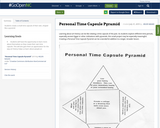
Students create a small time capsule of their own, shaped like a pyramid.
- Subject:
- Arts Education
- Visual Arts
- Material Type:
- Activity/Lab
- Date Added:
- 07/31/2019

Students create a small time capsule of their own, shaped like a pyramid.

This resource packet contains images and supplemental readings to be used when teaching with Peter Blume's painting "The Rock." Classroom activities and discussion questions are also provided.

This lesson plan offers the unique opportunity to see behind the scenes of the life of a political illustration artist. Students will learn how to use an illustration to express a political point while exploring many art mediums and self--expression.
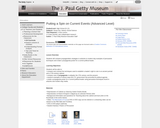
Students will compare propagandistic strategies in artworks to modern-day examples of persuasive techniques and create a propaganda poster for a current political leader.
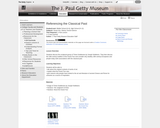
Students will be able to talk about the original contexts of works of art; explain what the Grand Tour was; and give reasons why people have looked to the art and literature of ancient Greece and Rome for centuries as a source of inspiration.

Students will be introduced to two new mediums: industrial design and photography; consider the ways in which art, architecture, and design affect their everyday life; consider the impact that the creation of public monuments has on a city and its citizens.

Students will learn about design issues including sustainability, safety, and use; explore how architects are using green technologies in today's buildings; investigate how the built environment affects the natural environment; investigate how the natural environment affects the built environment.

Students will explore the design process through photographic documentation and architectural plans and elevations; use primary-source documentation to explore the history of a building; compare and contrast works of architecture and industrial design; become familiar with the work of Mies van der Rohe and the International Style movement; learn the terms plan, elevation, cantilever, ornamentation, and scale.

Students will become familiar with the industrial developments of the twentieth century and how they affected architecture and society; explore the development of urban environments; compare and contrast graphics and drawings; create works of art that document their neighborhoods from their own perspectives; learn the terms utopian and conceptual.

Students will explore the inventions and material innovations that made the construction of skyscrapers possible; become familiar with the roles of architects and engineers; make connections between architecture and history; learn the terms ziggurat and cladding.
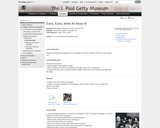
Students will be able to visually analyze a photographic image; write a headline and a story to accompany an image chosen from a newspaper; and compare what they see in a photojournalistic image to what they read in the story accompanying the image.
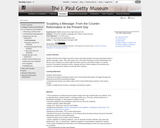
Students will be able to describe and analyze techniques artists use to communicate persuasive messages through two-dimensional and three-dimensional images; understand key themes and artistic styles of the Counter-Reformation period in 17th-century Europe; and create a sculpture that conveys a message conceived by a patron.
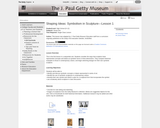
This is the first lesson in a sequential unit. Students consider the ways that sculptors have represented concepts and ideals as symbolic forms in three dimensions. They compare historical examples to those in contemporary culture, and begin sketching designs for their own symbolic sculpture.
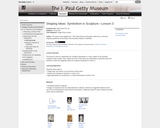
This lesson is part of a sequential unit. Students participate in a class critique of the symbolic sculptures they created. They critique the work of their peers by responding to questions about the symbolic content and applying criteria for sculpture developed in Lesson 1.

In this activity, students will learn how modern artists reinvented portraiture. By the turn of the 20th century, photographs had become the most accessible and popular mode of portraiture. As though freed from the burden of realism, portrait painters of the time began to explore new ways to represent people, breaking with the literal and representational portrait of the previous era.

In this activity, students learn about how artists living in the rapidly modernizing world of late 19th-century Europe wished not only to depict modern (for them, contemporary) everyday life, but also to reveal the emotional and psychological effects of living in a world in rapid flux.

Students discover the ways in which artists, photographers, and architects changed the landscape of modern cities. The emergence of the modern city in the early 1900s was shaped by industry, innovations in transportation (railroads in particular), and mass migrations of people.

Students will be able to research the history of individual labor unions and interview representatives about benefits and challenges; document in a photographer's journal the process of preparing for and participating in a photography assignment; formally analyze artworks in preparation for a photography assignment; and create an original photograph of a worker that uses leading lines to create emphasis.
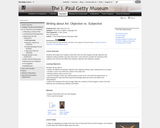
Students will analyze the sculpture Head with Horns by Paul Gauguin through objective and subjective writing activities and class discussion.

In this lesson, students learn about Irving Penn’s “The Small Trades” collection. They then scan The New York Times (or other newspapers) for photographs of people at work, clip these images for more in-depth examination, and take their own photographs of people on the job in their community for a class exhibit.
Students will:
1. Examine portraits from Irving Penn’s “The Small Trades” collection.
2. Learn about a famous collection of photographed portraits by reading and discussing the article “Blue-Collar Elegance: Getty Acquires Penn Series.”
3. Analyze images of people on the job clipped from copies of The New York Times (or other newspaper).
4. Take photographs of people in jobs that are either unique or typical to their local community.